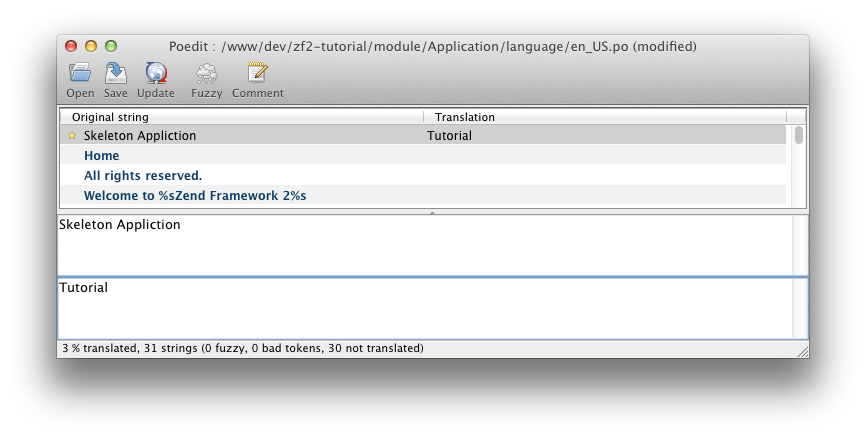Internationalization
Internationalization
If you are building a site for an international audience, you will likely want to provide localized versions of common strings on your website, including menu items, form labels, button labels, and more. Additionally, some websites require that route path segments be localized.
Zend Framework provides internationalization (i18n) tools via the zend-i18ncomponent, and integration with zend-mvc via the zend-mvc-i18n component.
Installation
Install zend-mvc-i18n via Composer:
$ composer require zendframework/zend-mvc-i18nAssuming you are using zend-component-installer (which is installed by default with the skeleton application), this will prompt you to install the component as a module in your application; make sure you select eitherapplication.config.php or modules.config.php for the location.
Once installed, this component exposes several services, including:
MvcTranslator, which implements the zend-i18nTranslatorInterface, as well as the version specific to zend-validator, providing an instance that can be used for all application contexts.- A "translator aware" router.
By default, until you configure translations, installation has no practical effect. So the next step is creating translations to use in your application.
Creating translations
The zend-i18n Translation chapter covers the details of adding translations to your application. You can use PHP arrays, INI files, or the popular gettext package (which allows you to use industry standard tools such as poedit to edit translations).

Once you have some translation sources, you will need to put them somewhere your application can access them. Options include:
- In a subdirectory of the module that defines and/or consumes the translation strings. As an example,
module/Application/language/. - In your application data directory; e.g.,
data/language/.
Make sure you follow the guidelines from the zend-i18n documentation with regards to naming your files. Additionally, you may want to further segregate any such directory by text domain.
From here, you need to configure the translator to use your files. This requires adding configuration in either your module or application configuration files that provides:
- The default locale if none is provided.
- Translation file patterns, which include:
- the translation source type (e.g.,
gettext,phparray,ini) - the base directory in which they are stored
- a file pattern for identifying the files to use
As examples:
// in a module's module.config.php:
'translator' => [
'locale' => 'en_US',
'translation_file_patterns' => [
[
'type' => 'gettext',
'base_dir' => __DIR__ . '/../language',
'pattern' => '%s.mo',
],
],
],
// or in config/autoload/global.php:
'translator' => [
'locale' => 'en_US',
'translation_file_patterns' => [
[
'type' => 'gettext',
'base_dir' => getcwd() . '/data/language',
'pattern' => '%s.mo',
],
],
],Once the above configuration is in place, the translator will be active in your application, allowing you to use it.
Translating strings in templates
Once you have defined some strings to translate, and configured the application to use them, you can translate them in your application. Thetranslate() and translatePlural() view helpers allow you to provide translations within your view scripts.
As an example, you might want to translate the string "All rights reserved" in your footer. You could do the following in your layout script:
<p>© 2016 by Examples Ltd. <?= $this->translate('All rights reserved') ?></p>Translating route segments
In order to enable route translation, you need to do two things:
- Tell the router to use the translation-aware route class.
- Optionally, tell it which text domain to use (if not using the default text domain).
To tell the application to use the translation-aware route class, we can update our routing configuration. Underneath the top-level router key, we'll add therouter_class key:
// In a module.config.php file, or config/autoload/global.php:
'router' => [
'router_class' => Zend\Mvc\I18n\Router\TranslatorAwareTreeRouteStack::class,
'routes' => [
/* ... */
],
],If you want to use an alternate text domain, you can do so via thetranslator_text_domain key, also directly below the router key:
// In a module.config.php file, or config/autoload/global.php:
'router' => [
'router_class' => Zend\Mvc\I18n\Router\TranslatorAwareTreeRouteStack::class,
'translator_text_domain' => 'router',
'routes' => [
/* ... */
],
],Now that the router is aware of translations, we can use translatable strings in our routes. To do so, surround the string capable of translation with braces ({}). As an example:
'route' => '/{login}',specifies the word "login" as translatable.
Internationalization的更多相关文章
- 国际化(Internationalization)
1:什么是国际化? 国际化(internationalization)是设计和制造容易适应不同区域要求的产品的一种方式.它要求从产品中抽离所有的与语言,国家/地区和文化相关的元素.换言之,应用程序的功 ...
- Struts2 internationalization(国际化)
1:什么是国际化? 国际化(internationalization)是设计和制造容易适应不同区域要求的产品的一种方式.它要求从产品中抽离所有的与语言,国家/地区和文化相关的元素.换言之,应用程序的功 ...
- Struts2(十三)国际化-internationalization
一.国际化是什么--I18N 即internationalization 首字母i-结束字母n之间有18个字母 特征:在程序不做修改的情况下,可以根据不同的语言环境显示相应内容 二.Java内置国际化 ...
- Struts2学习笔记 国际化(Internationalization)
概述 国际化(Internationalization),通途的讲,就是让软件实现对多种语言的支持.可以通过简单的设置就可以从一种语言切换到另一种语言.用的最多的地方就是在应用程序的界面表示上.我们经 ...
- 使用 PySide2 开发 Maya 插件系列三:qt语言国际化(internationalization)
使用 PySide2 开发 Maya 插件系列三:qt语言国际化(internationalization) 前言: 这是 qt for python 的语言国际化,基于 UI 的,python 也有 ...
- Internationalization(i18n) support in SAP CRM,UI5 and Hybris
i18n(其来源是英文单词 internationalization的首末字符i和n,18为中间的字符数)是"国际化"的简称.对程序来说,在不修改内部代码的情况下,能根据不同语言及 ...
- current status of the installation and the internationalization of Samba 3.0
Only about 8 months from release of Samba 3.0.0, there is beginning to be the transition from 2.2.x. ...
- i18n 和 L10n (internationalization and localization) 国际化与本地化(具有全球战略眼光的公司企业的必由之路)
i18n 和 L10n (internationalization and localization) 国际化与本地化(具有全球战略眼光的公司企业的必由之路) 1 1 https://zh.wiki ...
- Internationalization API & ECMA-402
Internationalization API & ECMA-402 i18n https://caniuse.com/?search=Internationalization API In ...
随机推荐
- 【转】eclipse新建项目,报错“Error: workspace\appcompat_v7\res\values-v21\styles_base.xml No resource found that matches the given name”
原文网址:http://www.cnblogs.com/mbp-study/p/5268478.html 新建项目报错,不知道为什么,以前从未出现过的错误,把sdk更新之后,出现莫名错误,自己也是一知 ...
- 静态Web开发 DOM
四章 Dom 1节dom中的顶级对象 dom(文档对象模型)js最终是要操作html页面,让html变成DHtml,而操作Html页面就要用到DOMDOM可以吧Html页面模拟成一个对象,如果js只是 ...
- C 语言控制台实现五子棋项目
花了一天时间实现了控制台五子棋项目,把项目贴上来.也算是告一段落了. 为了进一步了解C语言编程,熟悉优秀的编码风格,提升编码能力,丰富项目经验.所以在编程初期选择了控制台小游戏<单机五子棋> ...
- C# 发送邮件整理,包括控制台程序、WPF、WebForm 及 ASP.NET MVC
一直想把发送邮件的功能掌握,总是各种情况拖着了,这两天终于看了一下,整理一下,希望能帮到想学的. 发送邮件使用SMTP服务器,有两种方案,一种是使用IIS的SMTP功能:另一种是直接使用邮件供应商的S ...
- 【Kafka入门】Kafka基础结构和知识
基本概念的总结 在基本的Kafka架构中,producer将消息发布到Kafka话题中,一个Kafka话题通常指消息的类别或者名称,Kafka话题被集群中一个充当Kafka server角色的 bro ...
- 【Hadoop学习】Apache HBase项目简介
正在撰写,稍后来访……
- C#中使用DLL文件
首先,我们需要在C++程序中导出DLL文件.我使用的是Visual Studio开发,把项目"属性"中的“配置类型”改为"动态库dll",然后添加如下导出代码: ...
- Android下NFC的简单使用
现在很多手机已经配备了NFC(Near Field Communication 近场通信)的功能,我就为此专门研究过,可以到本文末尾下载源代码. Android官方资料:http://develope ...
- Redis+MongoDB 最佳实践 做到读写分离 -摘自网络
方案1. (被否定) 加上Redis,做到MongoDB的读写分离,单一进程从MongoDB及时把任务同步到Redis中. 看起来很完美,但是上线后出现了各种各样的问题,列举一下: 1.Redis队列 ...
- Fragment回调顺序及getActivity()为NullPointerException解决方法
Fragment回调顺序 onAttach->onCreate->onCreateView->onActivityCreated ps:最后发现经常在Fragment里面getAct ...
